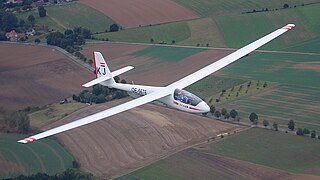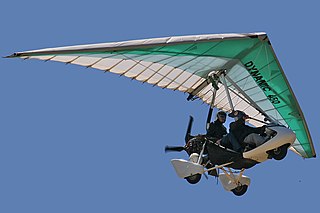
The AEG B.I was a German two-seat biplane unarmed reconnaissance aircraft produced in very small numbers in 1914. It formed the basis for the more successful B- and C-type aircraft from AEG.
The AEG B.III was a German two-seat biplane reconnaissance aircraft produced in very small numbers from 1915. It was a further refinement of the B.I and B.II, with a fresh tailplane assembly, but was still only just adequate in performance and did not attract much interest. The B.III was put into reconnaissance and training roles in 1915, but was soon replaced by armed aircraft in the German military.

The AEG G.II was a German biplane bomber aircraft of World War I developed from the AEG G.I, with more powerful engines. The G.II was typically armed with three 7.92 mm (.312 in) machine guns and 200 kg (440 lb) of bombs. The bomber suffered stability problems, and many G.IIs were fitted with additional vertical tail surfaces on each side of the fin and rudder to improve flight handling characteristics.

The AEG G.III was a German biplane bomber aircraft of World War I developed from the G.II. Like its predecessor, it was only built in small numbers and saw limited operational use, mainly far from the main fronts of the war.
The Martin XB-68 was a supersonic medium tactical bomber with a crew of two that was proposed in 1954 to the United States Air Force. The project, however, was canceled before any aircraft were built.

The Schleicher ASW 15 is a single-seat sailplane designed in 1968 by Gerhard Waibel and manufactured by Alexander Schleicher GmbH & Co. The ASW 15 has shoulder-mounted wings and an all-flying tailplane, with its single tow-release placement a compromise between winching and aerotowing. The later ASW 15B had several improvements, including a tow-release placed on the plane of symmetry, an 11 cm taller rudder, a slightly larger main wheel, and the provision of a 90-litre water ballast system.

The Scheibe Spatz is a German glider with a mixed metal and wood construction that was built in 1952 until 1962. Later versions were known as the L-Spatz, the letter L standing for Leistung, which is German for "performance".

The Bartlett LC-13A Zephyr 150 was a United States light civil aircraft built in the 1940s. It was a mid-wing braced monoplane of conventional design with side-by-side seating for two and fixed, tailwheel undercarriage. It was originally marketed as the Babcock LC-13 by its original manufacturer, then as the Taubman LC-13 when the Babcock Airplane Corporation was acquired by Taubman Aircraft. The rights were finally acquired by Bartlett Aircraft in 1941, but plans to mass-produce it were halted by the outbreak of World War II. There was a brief attempt to revive the design at the end of the war, but nothing came of this.
The ICA IS-32 is an open class high-performance metal two-seat sailplane produced in Romania in the 1970s. A refinement of the IS-28B, it shared most of that aircraft's fuselage, mated to new wings and empennage. This new wing had a span of 20 metres, featuring interconnected ailerons and flaps, Schempp-Hirth-type airbrakes. It had no provision for water ballast. The monowheel undercarriage differed from the IS-28 in being fully retractable.

The Sparmann S-1 was a 1930s Swedish military training monoplane, designed by Edmund Sparmann, built in small numbers for the Swedish Air Force. The S-1 was a single-seat low-wing braced-monoplane with a fixed trail-skid landing gear. It was powered by a single 130 hp (97 kW) de Havilland Gipsy Major engine.
The Chandelle Mk IV is an American ultralight aircraft that was designed by Nile Downer and produced by Chandelle Aircraft. The aircraft was supplied as a kit for amateur construction.
The Skye Treck Skyseeker is a Canadian ultralight aircraft that was designed and produced by Skye Treck of Manitoba. The aircraft was supplied as a kit for amateur construction.

The Albatros L102 / Albatros Al 102, was a German trainer aircraft of the 1930s. It was a parasol-wing landplane, seating the student pilot and instructor in separate, open cockpits. A biplane floatplane version was also built as the Al 102W, with strut-braced lower wings.
The Arplast Micro'B is a French ultralight aircraft that was designed and produced by propeller manufacturer Arplast Helice. It was supplied as a kit for amateur construction or as a complete ready-to-fly-aircraft.
The Horikawa H-23B-2 is a two-seat training glider designed and built in Japan in the 1950s. It was produced in small numbers.
The IS-3 was the basis of a family of high performance gliders designed by Iosif Şilimon and built in Romania in the 1950s at the URMV-3 factory at Braşov.

The DTA Dynamic is a series of French double-surface ultralight trike wings, designed and produced by DTA sarl of Montélimar. The wings are widely used on DTA trikes as well as by other ultralight aircraft manufacturers.
The Moyes Malibu is an Australian high-wing, single-place, hang glider designed and produced by Moyes Delta Gliders of Kurnell, New South Wales. The aircraft is supplied complete and ready-to-fly.
The Air Creation Pixel is a French ultralight trike, designed and produced by Air Creation of Aubenas. The aircraft is supplied complete and ready-to-fly or as a kit for amateur construction.

The Heinkel HD 14 was a single-engine biplane torpedo aircraft developed by the German aviation company Ernst Heinkel Flugzeugwerke in the 1920s, and produced in a single prototype, under license, from Swedish by Svenska Aero in Stockholm.










